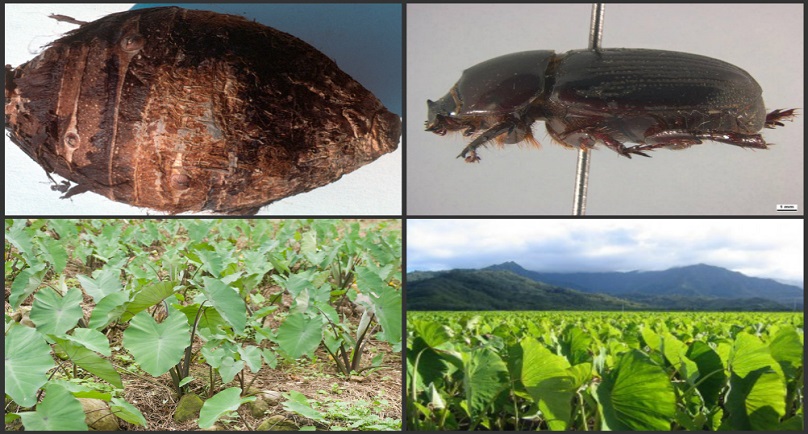By Sasha Pei-Silovo – EM TV Online
Papua New Guinea’s agriculture sector is faced with ongoing threats to taro species, caused by the taro beetle (pest) and taro leaf blight (disease). Both are proving to be extremely menacing to PNG’s taro industry, especially with new posed threats from climate change.
Cyril Atung, a scientist with the National Agriculture Research Institute, is in Vanuatu attending a regional workshop on taro, and its sustainability. Mr Atung, in an interview with Radio Australia, expressed the need for pesticides in the country, to fight the taro beetle and protect more than 800 local varieties of taro in PNG, and 1,000 imported varieties.
The adult taro beetles were first reported in Fiji, in 1984. The beetles are black in colour, shiny, and are usually 15 to 20 millimetres in length and fly from their breeding sites to taro fields, tunnelling their way into the soil at the base of the taro corms. Many species of the taro beetle have horns on their heads.
Once at the base of the taro corms, they begin to feed on the growing corm; eventually degrading the quality of the taro. The wounds these beetles create attract rot-causing organisms. This leads to the wilting, and even death, of affected taro plants.
Atung said that many PNG farmers were reluctant to use chemicals to fight the beetle and chose traditional methods, which he described as “time consuming”. He said that people had to be made aware of modern technology.
Taro beetles are also known to feed on and disfigure a range of crops, such as sugarcane, yams, banana, sweet potato (kaukau) and yams, among others.
“With this climate effect there is no way back, we have to adapt to any changes. We are emphasising the use of chemical control. Once climate change occurs, it will start to introduce other pests and diseases. It may also contribute to introducing another species of beetle so we are afraid of that and we are concerned,” stated Mr Atung.
Countless efforts have been imposed, in developing effective control measures for the taro pest. Earlier recommendations of the use of Lindane in PNG to control the taro beetle, proved unsustainable for the environment.
Lindane is an antiquated and toxic pesticide, once used extensively worldwide. Lindane has since been banned, globally, from agricultural use. However, the pesticide, a potent neurotoxin, is still used in the USA, in shampoos and lotions, to control head lice and scabies. The State of California, however, banned these pharmaceutical uses in 2001.
Other insecticides used in taro beetle control have been ineffective, along with the use of physical barriers, such as fly wire or shade cloth spread over the soil. The most recent research efforts are now concentrating on finding an effective biological control, with much of this research are taking place in Papua New Guinea and the Solomon Islands, supported by the Pacific Regional Agricultural Programme (PRAP).


